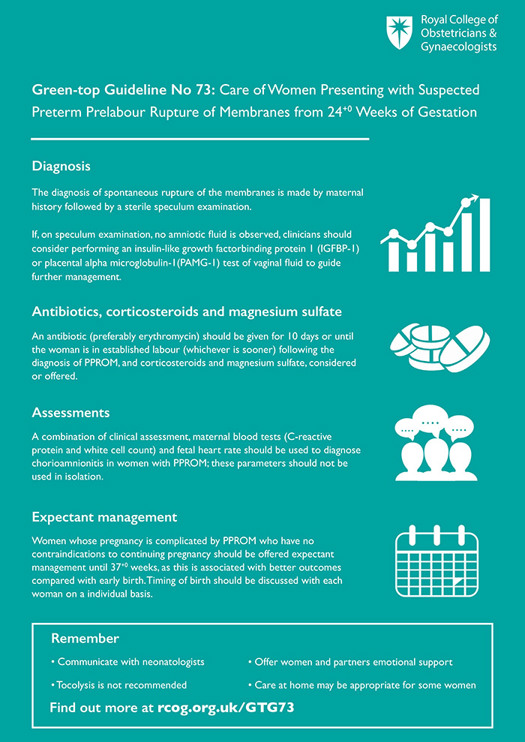Summary
Preterm prelabour rupture of membranes (PPROM) complicates up to 3% of pregnancies and is associated with 30-40% of preterm births. PPROM can result in significant neonatal morbidity and mortality, primarily from prematurity, sepsis, cord prolapse and pulmonary hypoplasia. In addition, there are risks associated with chorioamnionitis and placental abruption.
This guideline comprises recommendations relating to the diagnosis, assessment, care and timing of birth of women presenting with suspected PPROM from 24+0 to 36+6 weeks of gestation. It also addresses care in a subsequent pregnancy.
Update June 2022: This guideline cites NICE guideline NG25 Preterm labour and birth, last updated August 2019, which recommends offering antenatal corticosteroids for up to 33+6 weeks gestation and considering up to 35+6 weeks gestation. In February 2022 the RCOG published Green-top Guideline No 74: Antenatal Corticosteroids to reduce neonatal morbidity and mortality, which cites new evidence from the recent Cochrane systematic review on the topic, recommending antenatal corticosteroids to be offered up to 34+6 weeks gestation with careful consideration of the benefits versus harms for use beyond this gestation. Please also refer to this guideline and associated enhanced content regarding the use of antenatal corticosteroids steroids in PPROM.
COVID disclaimer
This guideline was developed as part of the regular updates to programme of Green-top Guidelines, as outlined in our document Developing a Green-top Guideline: Guidance for developers, and prior to the emergence of COVID-19.
Version history
This is the first edition of this guideline.
The guideline was reviewed in October 2024 and extended for 2 years. The review process will commence in 2026, unless otherwise indicated.
Developer declaration of interests
Dr A Thomson: None declared.
Summary graphic
Read plain text below graphic.

Diagnosis
The diagnosis of spontaneous rupture of the membranes is made by maternal history followed by a sterile speculum examination.
If, on speculum examination, no amniotic fluid is observed, clinicians should consider performing an insulin-like growth factorbinding protein 1 (IGFBP-1) or placental alpha microglobulin-1 (PAMG-1) test of vaginal fluid to guide further management.
Assessments
A combination of clinical assessment, maternal blood tests (C-reactive protein and white cell count) and fetal heart rate should be used to diagnose chorioamnionitis in women with PPROM; these parameters should not be used in isolation.
Antibiotics, corticosteroids and magnesium sulfate
An antibiotic (preferably erythromycin) should be given for 10 days or until the woman is in established labour (whichever is sooner) following the diagnosis of PPROM, and corticosteroids and magnesium sulfate, considered or offered.
Expectant management
Women whose pregnancy is complicated by PPROM who have no contraindications to continuing pregnancy should be offered expectant management until 37+0 weeks, as this is associated with better outcomes compared with early birth. Timing of birth should be discussed with each woman on a individual basis.
Remember:
- Communicate with neonatologists
- Offer women and partners emotional support
- Tocolysis is not recommended
- Care at home may be appropriate for some women
